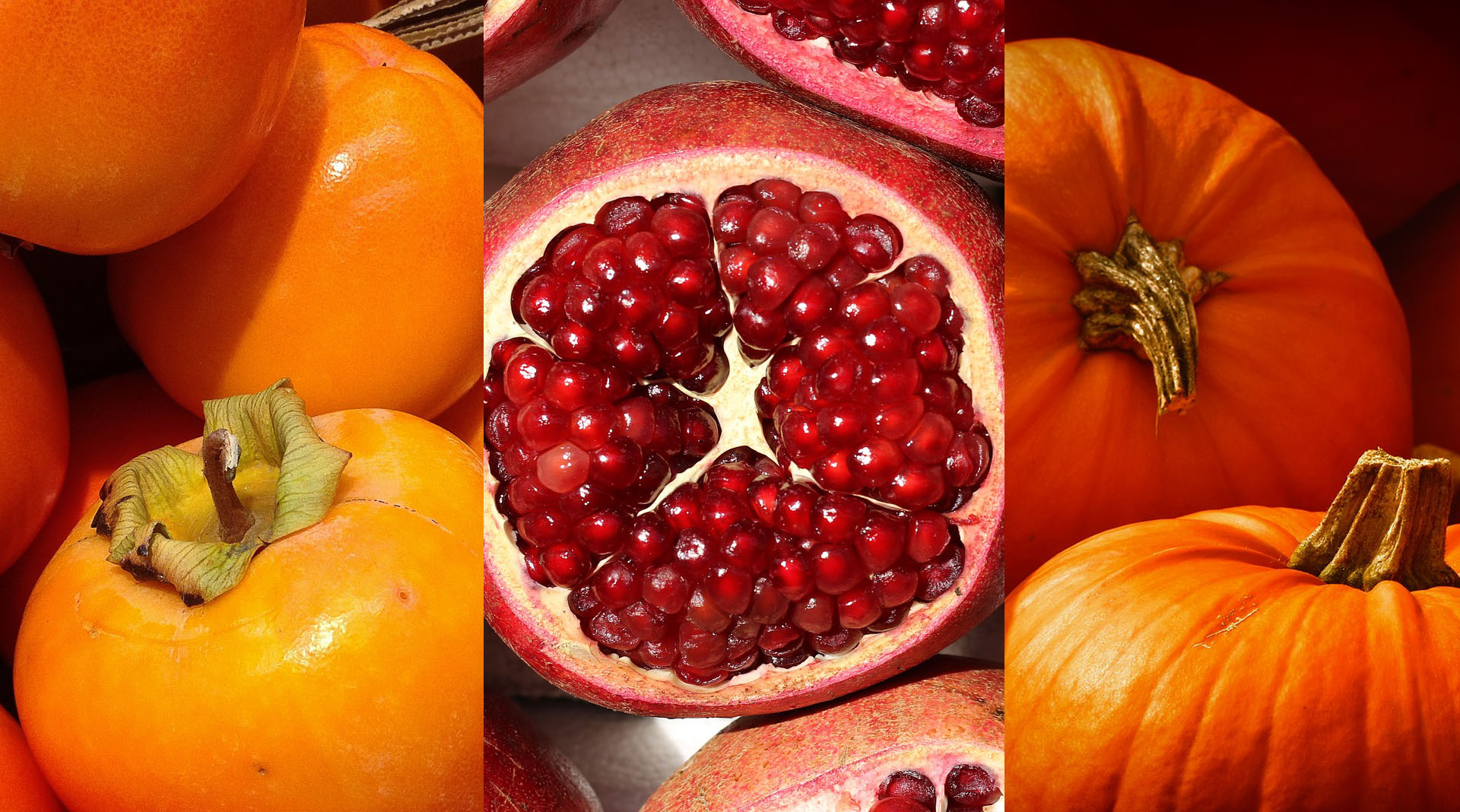The 3 Ps of What to Eat in Fall: Pumpkin, Persimmon, and Pomegranate

PREMIUM CONTENT for MEMBERS ONLY
By Jill Horn
Fall is officially coming to its end and winter is about to start. Not only do the leaves turn orange and red during fall time, but so do the foods on our plates. If you eat seasonally, the benefits of which have been discussed in a previous post, you may have been consuming different kinds of pumpkin, as well as purchasing persimmons or pomegranate for your fruit bowl. Eating seasonally can enhance nutrient density of your diet while also positively affecting the environment. This article will discuss the health benefits of three different fall foods, pumpkin, persimmon, and pomegranate, all of which are not only delicious but also add warm colors to your kitchen and plate during the colder seasons.
Pumpkin probably is the one food that is associated most with fall season. There are many different types of pumpkin and squash, each characterized by their unique nutritional profile. As a member of the Cucurbitaceae family, consuming pumpkins has been associated with a variety of health benefits such as improved cardiovascular health, anti-tumor activity, antidiabetic effects, antifungal activity, and anti-inflammatory effects. Carotenoids are one component abundant in all different kinds of pumpkin, which have strong antioxidant effects. These plant molecules are responsible for giving pumpkin its orange color, and have been shown to enhance immune function, protect from sunburn, and delay the onset of certain types of cancer. A popular type of pumpkin is butternut squash, known as Cucurbita moschata in the scientific community. Butternut squash has traditionally been used in holistic medicine in many different countries. Its richness in vitamins A, B, and C, various minerals, carotene, essential amino acids, and trace elements such as manganese, magnesium, calcium, and potassium make it a nutrient-packed food with many health boosting effects. Moreover, winter squash contains high amounts of dietary fiber, contributing to gut microbial diversity and richness.
Persimmons (Diospyros kaki L.) are one of my personal favorite seasonal foods due to their sweet flavor and unique texture. This fleshy and fibrous tropical fruit belongs to the Ebenaceae family and is native to China, Taiwan, and Myanmar. Even though native to Asia, persimmons have been cultivated in many different regions of the world, such as in the Mediterranean. The sweet, orange fruit is typically harvested late September until early January, making it a typical fall and winter food. As with many other fruits, the concentration of nutrients in persimmons is higher in the skin than in the flesh, so people who eat the pulp without the skin may want to consider giving the skin (of organically grown fruit) a try. Persimmons have an impressive nutritional profile with many different bioactive compounds such as fiber, vitamin C, as well as minerals such as iron, calcium, zinc, magnesium, and potassium. Persimmons are also rich in polyphenols, such as proanthocyanins, and gallic acid, flavonoids, terpenoids, saponins, and tannins. This richness in nutrients and polyphenols has been associated with the fruit’s reported health benefits, including anti-tumor properties, lowering of blood lipids and cholesterol and antidiabetic effects. prevention of dyslipidemia, anti-hypercholesterolemic effects, and antidiabetic effects.
Pomegranate is also known as Punica granatum L. and has been a symbol for life, luck, abundance, and fertility in many different cultures and religions. It is an ancient fruit which is native to west Asia but can also be found in the Mediterranean area and Middle East. Consumption of Pomegranate juice and seeds have been associated with a range of health benefits, which have been attributed to its high concentration of various polyphenols, in particular ellagitannins, gallic acid, anthocyanins, and flavonoids. In fact, clinical studies have shown that daily pomegranate juice consumption can lessen hypertension and attenuate atherosclerosis in humans. Pomegranate has further been used as adjuvant therapy for the treatment of prostate cancer and other types of cancer. Ellagitannins, gallotannins, and gallic acid are thought to be the most important bioactive compounds of pomegranate, together with anthocyanins which are responsible for the fruit’s bright red color.
Knowing that the nutrient density of these delicious plant foods will be at its maximum during the next few weeks, I hope that you will get to enjoy many of the above-named benefits, not to forget their delicious flavor and beautiful appearance.
 Jill Horn is a recent UCLA graduate with a degree in Neuroscience. She is deeply interested in the interconnectedness of body, mind, and spirit takes an integrative approach to health and well-being.
Jill Horn is a recent UCLA graduate with a degree in Neuroscience. She is deeply interested in the interconnectedness of body, mind, and spirit takes an integrative approach to health and well-being.